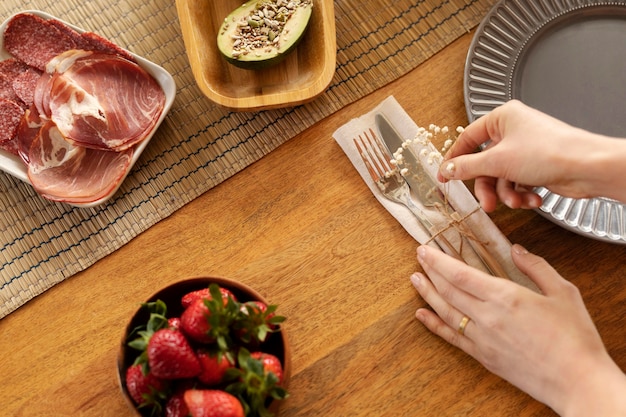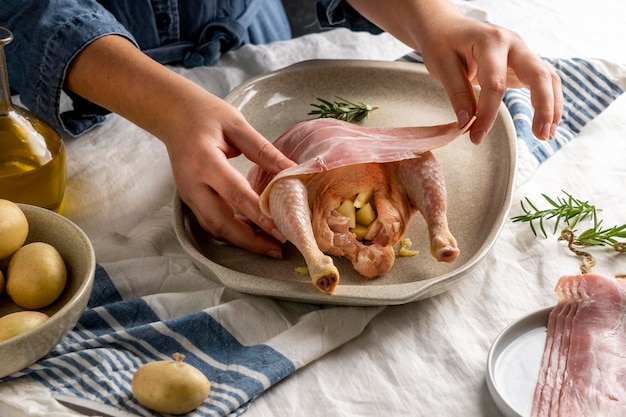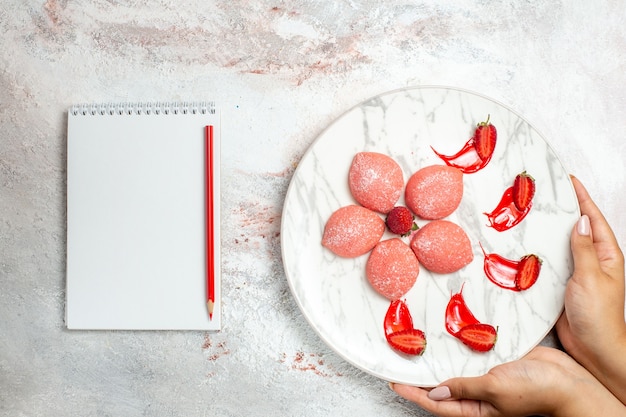Let's face it, a spiral ham is a classic for a reason. It's a beautiful centerpiece, it smells divine, and it's surprisingly easy to cook. I've been making spiral ham for years now, and I've learned a thing or two along the way. So, buckle up, because I'm about to share all my secrets to creating a perfect spiral ham that'll have everyone singing your praises.
(Part 1) Getting Started: Choosing the Right Ham

First things first, you need the right ham to start with. There are a few different types, and understanding the differences is key to choosing the perfect one for your needs.
Types of Spiral Ham: A Quick Breakdown
- cured ham: This is your everyday, run-of-the-mill spiral ham. It's already been cooked, so all you need to do is heat it through. You can usually find these in the deli section of your supermarket, ready to be glazed and devoured.
- uncured ham: This one takes a bit more effort as it hasn't been pre-cooked. You'll need to cook it from scratch, but the flavor is worth it! Uncured hams are less common, so you might have to hunt around a bit at specialty stores.
- Bone-in or Boneless: This choice comes down to personal preference. bone-in hams are usually more flavorful because the bone helps to retain moisture during cooking. They also tend to be a little more economical. However, boneless hams are easier to slice and serve. If you're dealing with a large group, boneless might be the way to go.
Key Features to Look For
You've got your options down, now it's time to pick the perfect ham. Here's what to keep an eye out for:
- Color: A healthy ham should be a nice, even pink color. Avoid any that look pale or have a gray tinge.
- Aroma: A good ham has a pleasant, slightly smoky aroma. If it smells sour or off, it's best to steer clear.
- Moisture: The ham should feel slightly damp but not wet. This indicates that it's been properly cured and stored.
(Part 2) Cooking Methods: The Basics

Alright, you've got your ham, now it's time to get cooking! There are two main ways to cook a spiral ham, and both are relatively simple. You can't go wrong with either one.
Oven Baking: A Tried and True Method
This is the most common way to cook a spiral ham and for good reason. It's reliable, easy, and gives you a beautifully cooked ham every time. Here's the breakdown:
- Preheat your oven: Set it to 325°F (160°C). This is the sweet spot for a juicy ham.
- Place the ham in a roasting pan: You can use a roasting rack to elevate the ham, ensuring even cooking. If you don't have a rack, it's perfectly fine to place it directly in the pan, just make sure it's not touching the bottom.
- Cover the ham: This is important! It helps the ham retain moisture and prevents it from drying out. You can use foil, parchment paper, or a roasting lid.
- Bake until heated through: The general rule of thumb is about 15-20 minutes per pound. However, it's always best to use a meat thermometer. You want the internal temperature to reach 140°F (60°C). Remember, this is for heating through, not cooking from raw.
slow cooker: A Hands-Off Approach
If you're looking for a more laid-back approach, the slow cooker is your friend. It's a fantastic option for a hassle-free meal. Here's how it works:
- Place the ham in the slow cooker: Make sure it fits comfortably.
- Add some liquid: This helps keep the ham moist and adds flavor. You can use water, apple juice, or even beer. It's up to you!
- Cook on low heat for 4-6 hours, or on high for 2-3 hours. The slow cooker does all the work, so you can relax and let the magic happen.
(Part 3) Glazing: Taking It to the Next Level

Now, let's talk about the real star of the show: glaze! A good glaze adds that extra oomph to your ham, giving it a beautiful shine and a mouthwatering flavor. It's the finishing touch that makes all the difference.
Classic Glazes: Timeless Favorites
- brown sugar glaze: This is a true classic. It's simple, sweet, and everyone loves it. For a bit of extra flair, you can add a pinch of cinnamon or ginger.
- honey mustard glaze: This tangy and sweet glaze is perfect for those who like a bit of a kick. The honey adds a touch of sweetness, while the mustard brings a satisfying sharpness.
- pineapple glaze: This tropical glaze is always a hit! It adds a touch of sweetness and acidity, perfect for balancing the savory flavors of the ham. You can use canned pineapple chunks or even fresh pineapple.
Get Creative: Make Your Own Glaze
There's no limit to the creativity you can bring to your glazes. Think about your favorite flavors and experiment! Just make sure to use ingredients that can withstand high temperatures. Here are a few ideas to get your creative juices flowing:
- Maple Syrup Glaze: This glaze is rich and sweet with a lovely depth of flavor that pairs beautifully with ham.
- cherry glaze: If you're a fan of fruity glazes, this one is a winner. The tartness of the cherries cuts through the richness of the ham, creating a wonderful contrast.
- Spicy Glaze: Add a kick to your glaze with chili powder, cayenne pepper, or sriracha. It's a great way to add a touch of heat to your ham and tantalize your taste buds.
(Part 4) Serving Time: Let's Eat!
Your ham is cooked, it's glazed, and it's time to enjoy the fruits of your labor! But before you dive in, it's a good idea to let the ham rest for a bit. This allows the juices to redistribute, resulting in a more tender and flavorful ham. While the ham rests, you can get those sides ready. mashed potatoes, green beans, roasted vegetables, fruit salad... the possibilities are endless! Don't forget some crusty bread for dipping!
(Part 5) Leftovers: Don't Waste Them!
Let's be honest, you're probably going to have leftovers. And that's a good thing! Ham is incredibly versatile and makes a fantastic addition to a variety of dishes. Don't just eat it plain, get creative!
Creative Leftover Ideas:
- ham and cheese quiche: This is a quick and easy way to use up leftover ham. It's a delicious and satisfying breakfast or lunch option.
- Ham and bean soup: A hearty and comforting soup that's perfect for a cold day. The ham adds a rich depth of flavor to this classic soup.
- Ham and Potato Hash: A classic breakfast dish that's perfect for brunch. The ham adds a smoky and salty flavor to this hearty dish.
- Ham and Pineapple Pizza: A sweet and savory pizza that's a real treat. The ham and pineapple combination is a classic for a reason, and it's perfect for a fun family meal.
(Part 6) Tips and Tricks: Helpful Hints
I've shared a lot of information about spiral ham, but there are always a few extra tips that can make all the difference. Here are some of my favorites:
Temperature Is Key:
Using a meat thermometer is essential when cooking a ham. It's the only way to guarantee that it's cooked through to the safe temperature. Aim for an internal temperature of 140°F (60°C). This is especially important for pre-cooked hams, as you are just heating them through, not cooking them from raw.
Don't Overcook:
You don't want to dry out your ham. Cook it slowly at a low oven temperature. This helps to retain moisture and results in a tender and flavorful ham. The slower the better!
Glazing Timing:
Glaze your ham in the last 30 minutes of cooking. This gives the glaze enough time to caramelize and develop a beautiful sheen. You can brush it on several times during those last 30 minutes for an extra layer of flavor and a stunning presentation. If you glaze too early, it'll burn, and no one wants a burnt glaze.
Keep It Moist:
Cover your ham with foil or parchment paper for the first part of the cooking process. This helps to retain moisture and prevent it from drying out. Only remove the cover in the last 30 minutes to allow the glaze to caramelize. You can also add a cup of liquid to the bottom of your roasting pan. Water, apple juice, or even beer will work. The liquid will help to keep the ham moist and flavorful.
(Part 7) side dishes: Perfect Pairings
Now, let's talk about those delicious side dishes that complement your magnificent ham. You need something to round out the meal, right?
Classic Side Dishes: Always a Hit
- Mashed Potatoes: A classic pairing for ham, mashed potatoes are creamy, comforting, and always a winner.
- green bean casserole: This creamy and comforting side dish is a holiday staple. The crispy fried onions add a nice texture contrast to the creamy casserole.
- sweet potato Casserole: This sweet and savory side dish is a perfect complement to the ham. The sweet potatoes are naturally sweet, and the topping adds a nice crunchy texture.
Creative Side Dishes: Think Outside the Box
Don't be afraid to get a little more adventurous with your side dishes. Here are a few creative options that will impress your guests:
- Roasted Vegetables: A colorful and healthy side dish that's packed with flavor. You can roast any combination of vegetables you like. Try carrots, potatoes, asparagus, broccoli, or Brussels sprouts.
- Fruit Salad: A refreshing and light side dish that provides a nice contrast to the richness of the ham. Use your favorite fruits, like strawberries, blueberries, grapes, and melon.
- Pasta Salad: A fun and easy side dish that's perfect for a crowd. You can use any type of pasta you like, and add your favorite vegetables, cheese, and dressing.
(Part 8) Wine Pairing: The Perfect Complement
No meal is complete without a good glass of wine, and ham is no exception. The sweet and smoky flavors of ham pair beautifully with a variety of wines. Here are a few suggestions to help you find the perfect match.
White Wine: Crisp and Refreshing
- Riesling: The sweetness of Riesling balances the salty and smoky flavors of the ham. Look for a Riesling with a bit of residual sugar to enhance the sweet notes of the ham.
- Sauvignon Blanc: This crisp, dry wine has bright acidity that cuts through the richness of the ham. The herbal and grassy notes of Sauvignon Blanc complement the savory flavors of the ham.
Red Wine: Bold and Balanced
- Pinot Noir: This light-bodied red wine has a smooth and fruity character that pairs well with ham. The red fruit flavors of Pinot Noir complement the sweetness of the ham, while its light tannins won't overpower the delicate flavors.
- Zinfandel: This full-bodied red wine has bold flavors that can stand up to the richness of the ham. The spicy and peppery notes of Zinfandel enhance the savory flavors of the ham, while its sweetness complements the glaze.
(Part 9) FAQs: Your Most Burning Questions Answered
I've answered a lot of questions about spiral ham already, but here are some that I get asked all the time.
Q: How do I reheat spiral ham?
A: The best way to reheat spiral ham is in the oven. Preheat your oven to 325°F (160°C). Place the ham in a roasting pan and cover it with foil. Bake for about 15-20 minutes, or until heated through. You can also reheat it in the slow cooker on low for a few hours. Just add a cup or two of water or apple juice to the bottom of the slow cooker. This will help to keep the ham moist.
Q: How long can I keep leftover ham in the fridge?
A: You can keep leftover ham in the refrigerator for up to 4 days. Be sure to store it in an airtight container or wrap it tightly in plastic wrap. This will help to prevent it from drying out and absorbing other flavors in the fridge.
Q: Can I freeze leftover ham?
A: Yes, you can freeze leftover ham. Wrap it tightly in plastic wrap and then place it in a freezer-safe bag. It will last in the freezer for up to 3 months. Thaw it in the refrigerator overnight before reheating. Freezing can sometimes affect the texture of the ham, so it might be slightly drier after freezing.
Q: What's the difference between a spiral ham and a regular ham?
A: A spiral ham is a whole ham that has been boned and rolled, then sliced in a spiral pattern. This makes it easier to cook and carve. The spiral cuts allow for even cooking and make it easier to slice the ham after it's cooked. A regular ham is a whole ham that has not been boned or rolled. You can also find ham steaks, which are just slices of ham.
Q: How much spiral ham should I buy?
A: A general rule of thumb is to buy about 1/2 pound of ham per person. But you know, you can always err on the side of more. I'm always happy to have leftovers! It's always better to have too much than not enough, right?
(Part 10) Conclusion: Go Forth and Cook!
There you have it! You're now armed with all the knowledge you need to create a delicious and impressive spiral ham. Remember, confidence is key, creativity is encouraged, and deliciousness is guaranteed. So, go forth and make that perfect holiday meal. I know you're going to nail it! And if you ever have any more questions, don't hesitate to reach out. Happy cooking!
Everyone is watching

How to Cook Frozen Lobster Tails Perfectly: A Step-by-Step Guide
RecipesLobster. Just the word conjures up images of lavish meals, special occasions, and a taste of luxury. But let's...

Pigs in a Blanket Cooking Time: How Long to Bake for Perfect Results
RecipesAh, pigs in a blanket. Just the name conjures up images of those delightful little parcels of crispy pastry en...

Pork Fillet Cooking Time: How Long to Cook It Perfectly
RecipesPork fillet, or tenderloin as it's sometimes called, is a real favourite in our house. It's so versatile, and...

The Ultimate Guide to Cooking Delicious Frankfurters
RecipesLet's face it, we all love a good frankfurter. It's a classic, simple, and always satisfying. But let's be rea...

Wolf Meat Recipes: A Guide to Cooking Wild Game
RecipesLet's be honest, you don't see wolf meat at your local butcher shop every day. It's a bit of a wild card, but ...
